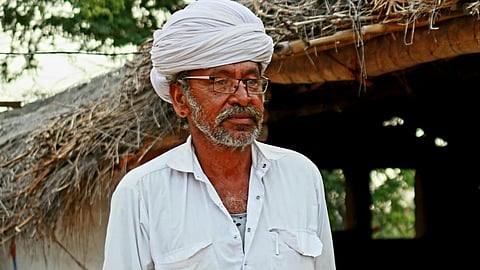Turbans mark castes in Jodhpur | Travelogue
The jeep winds its way through the forest and enters a residential area where elderly men in turbans, conspicuous by their silence, stay glued at bustling junctions. There is an abundance of vibrant red, with women dressed in bright red robes and adorned with traditional jewellery carrying mounds of grass on their heads.
Children wave to the travellers and at times even follow the vehicles for a short distance.
As Kuldeep spots people walking from a distance along the rugged road, he says, "Bishnoi, Gypsy, Rajput, Shepherd, Brahmin...”
Each community distinguishes itself with its own distinct coloured turbans, almost like billboards atop their heads! Red turbans for cattle herders, white for Bishnois and Rajputs sport turbans in five colours. That's how it all goes. Each village is predominantly inhabited by a single community, and they prefer not to mix.
Beyond the bustling areas, the jeep moves into the expansive deserted plains. In the distance, amidst the vast farmlands, are simple grass-thatched open structures, with no doors, not even the full four walls, entwined with creeping plants. These are where not just people stay protected from the scorching sun, but also roosting places for birds.
We were invited to Jaswant Lal Bishnoi's house for what can be described as an ‘opium ceremony’. In the room, there was a cot for the guests in the room. Another room within the courtyard was meant exclusively for women of the household. There was also a kitchen, although the hearth seemed to have been unused for a considerable period. Most of the family members spend over half the year on their farms.
Jaswant Bishnoi seemed to be waiting for the visitors. Clad in a soiled white dhoti and shirt, Jaswant’s bespectacled face painted a picture of misery. On the wall, there were soiled turbans and dupattas adorned with glass panes for the use of visitors.
Opium dissolved in water is filtered through an apparatus with a Shivalinga in its centre, and the entire process shares likeness with the anointing of the idol. The strained substance is then distributed as prasad, but exclusively to adults. Finally, his assistant offered us relishing masala tea in earthen cups.
But as we stepped out, we were left wondering why he had tried so hard to host us.
Kuldeep made every effort to convey that the hospitality was a manifestation of the ideal 'Aditi Devo Bhavah' where the guest is the god. However, the destitution in which Jaswant lived, so isolated, vividly revealed his poverty. This became even more apparent when he accepted some money with folded hands that we offered before taking leave.
After leaving Jaswant’s mud hut and passing through the gate with a long cut sandstone slab, we continued our road journey to a weavers’ village. Satyavrat Rathod’s dwelling was quite similar to Jaswant’s, albeit somewhat larger. Another concrete-roofed house was under construction on the premises. Kuldeep explained that Rathod was not a Rajput like him but rather a Banjara, essentially nomadic in nature.
We walked past a courtyard where beans of the Khejri tree, which Kuldeep had shown us in the forest earlier, were left for drying. We moved to Rathod's loom, essentially made of locally available logs and wood, nothing like the sophisticated looms in places like Chendamangalam or Balaramapuram in Kerala. Here they wove carpets, the thick and special ones used for wall decorations.
He offered us a carpet, not much bigger than a lungi, which he was about to finish weaving, and quoted a price of Rs 30,000. He claimed it would be much more expensive in showrooms, and his products were being exported.
On learning that I was a journalist, Rathod retrieved a large album from beneath the loom and proudly displayed articles about him in English publications both within and outside the country. He had neatly cut, clipped and preserved the articles.
Rathod then led us to a slightly larger hall beyond the boundary wall where he provided us with rope-knotted stools to sit on. We observed that his left leg was shorter than the right one, but this physical difference did not seem to impede his agility in any manner.
“This hall was built during the lockdown period when I had very little work. It was more of a pastime project, but now serves as a space to receive guests,” he said with a hearty laugh.
Neither the costumes, nor the surroundings can give us any idea about the conditions in which Jaswant Lal Bishnoi and Satyavrat Rathod live. But that they are two different levels is evident in their body language.
Not far from there, is the village exclusively inhabited by the Muslim community known for their pottery and statue-making skills. A few European tourists were present, which limited our opportunity to engage with the main artist. He was busy taking out earthen pots and dolphin statues from the wheel with dexterity while providing a running commentary.
Before leaving, we inquired about the price of a small Buddha bust among the various statues stacked there. "Three Hundred," he said. But he quietly approached us as we were about to step out and said, "Teen sau toh inkheliye, aapko sirf do sau,” indicating that it was Rs 300 because the foreigners were present, but Indians could purchase it at just Rs 200. We got two Buddha busts wrapped in a cloth bag and resumed our journey on the forest trail in the jeep.
(To be continued)
Part 1: Bishnois – the sentinels of nature
Part 2: Turbans mark castes in Jodhpur
Part 3: Harems turn into rental apartments
Part 4: The Rajas of Rajputana
Part 5: Marwar's Festival of Tastes


